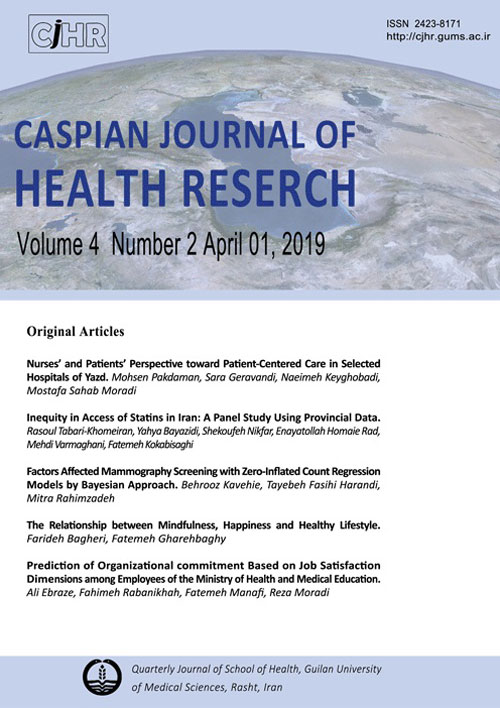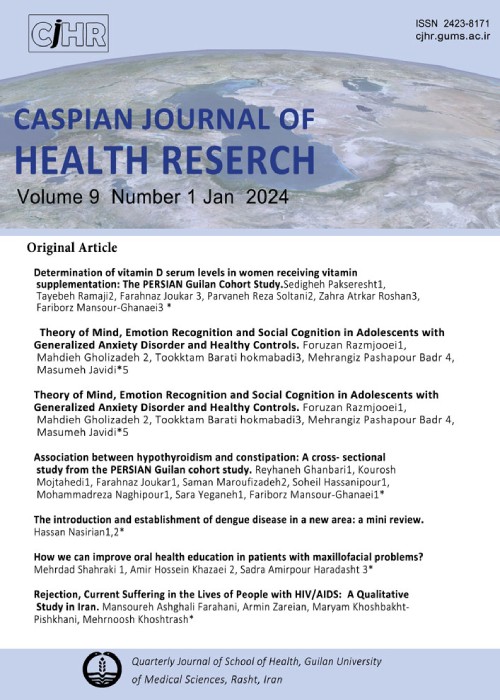فهرست مطالب

Caspian Journal of Health Research
Volume:4 Issue: 2, Jun 2019
- تاریخ انتشار: 1398/01/31
- تعداد عناوین: 5
-
Pages 28-32BackgroundOver the past two decades, patient-centered care has become one of the important dimensions of health care delivery, given that patients are expected to receive appropriate care from the service center. This study aimed to evaluate the various dimensions of patient-centered care from the viewpoint of nurses and patients in order to improve the patient-centered care of health services.MethodsThis cross-sectional study was conducted on two hospitals in city of Yazd, Iran. A total of 100 nurses and 100 patients were selected by simple random sampling method. Data was collected using a validated questionnaire and analyzed using one-way ANOVA test.ResultsThe mean score of patient-centered care was 2.34 (standard deviation (SD) = 0.58) from nurses' point of view and 2.23(SD = 0.07) from patients' point of view. The dimensions of patient's dignity, patient's values and social support for the patient had the highest score and quick attention to the patients had the lowest score from nurses’ perspectives. Respecting dignity and quality of health service provider had the lowest score from the patients’ viewpoint. The quality of health service received significantly lower score from the patients than the nurses (P-value = 0.03).ConclusionThe quality of the physical environment, observance of the patient's dignity and quick considered as the priority of action to improve the patient-centered care. It is recommended that the authorities should give priority to these dimensions in order to increase satisfaction and loyalty of patients.Keywords: Nurse, Patient, Patient-centered care, Quality of Health Care
-
Pages 33-37BackgroundStatins are among useful drug to prevent hyperlipidemia and subsequent cardiovascular diseases. Having an equal access to these drugs are very important for health policy makers.MethodsProvincial data of statin supply for Iran in 2013 were used in this study. Concentration index, GINI coefficient, concentration curve and Lorenz curve were calculated to show the level of inequality in access of statins. The percentage of population more than 65 years old was used as the need index. A panel data regression was used to estimate the contributing factors of inequality.ResultsGINI index was 0.297 for lovastatin, 0.322 for atorvastatin and 0.526 for simvastatin. GINI index for overall statin use was 0.303. Concentration index was not significant for atorvastatin and simvastatin while it was 0.160 for lovastatin. The coefficient of income was -1.75 for lovastatin, 1.04 for atorvastatin and -1.117 for simvastatin. The regression model showed that household income was independently contributed to decrease in Lovastatin (B = -1.752) and Simvastatin (B = -1.118) and increase in Atorvastatin (B = 1.04) access. Higher percentage of people with academic education, the number of physician, and price of drug were another significant predictors of statin access.ConclusionThe inequality for access in Simvastatin was greater than other statins. Household income and price of drug were among important contributors of statin access. For increasing access to statins it is suggested to increase the coverage of health insurance.Keywords: Concentration index, Inequality, Iran, Panel data, Statins
-
Pages 38-43BackgroundMammography is a valuable tool for early diagnosis of breast cancer in asymptomatic women. Considering the high prevalence of breast cancer in Iranian women and the low participation in mammography screening program, the purpose of this study was to investigate the factors affecting frequency of mammography screening in women over 40 years of age using zero-.MethodsIn this study, the required information about number of performing mammography in women’s’ lifetime, demographic characteristics and behavioral risk factors were obtained through interview based on a researcher-made questionnaire. To investigate the factors affecting mammography, zero inflation Poisson regression models were performed using Win Bugs software.ResultsThe mean (SD) age of women participating in this study was 49.87 (6.76). 77% of the participants have never undergone mammography, 8.9% once, 6.9% twice, 6.7% three times, and 0.5% more than three times. Age had a positive effect on the number of mammograms in the women who have perform mammograms at least once. Having a family history of cancer and breast cancer, middle compared to low economic status, higher compared to low education and menopause were significantly associated with lower probability of never performing mammography.ConclusionGiven the relatively low participation of women in mammography, more facilities are needed for high risk women (aged 40-70) to facilitate the diagnosis process.Keywords: Mammography, Breast cancer, Zero-Inflated, Poisson Regression, Bayesian Approach
-
Pages 44-48BackgroundHealthy lifestyle is the cornerstone of preventing chronic diseases. In this study, we aimed to investigate the association between mindfulness and happiness with healthy lifestyle.MethodsThis cross-sectional study was performed on students at Islamic Azad University South of Tehran. A total of 250 students were selected using simple random sampling method. Data were gathered using three questionnaires of five facet mindfulness, Oxford Happiness and healthy lifestyle. The association between variables were assessed using correlation coefficient and linear regression method.ResultsOf total, 203 people participated in the study. The mean age of participants was 32.2 (standard deviation = 10.8). The majority of them were women and married. The results of regression analysis showed that mindfulness and happiness had a positive and significant correlation with healthy growth.ConclusionAccording to the results, the findings of this study can be used to design conceptual models and enrichment of the theory of mindfulness and happiness in order to plan programs for improving the lifestyle of individuals.Keywords: Happiness, Healthy lifestyle, Mindfulness, Psychology
-
Pages 49-53BackgroundConsidering the key role of the Ministry of Health staff in developing major policies of the country and the importance of the health system employees in improving productivity and achieving the goals of the organization, the purpose of this study was to predict organizational commitment based on the dimensions of job satisfaction in the staff of the Ministry of Health, and medical education.MethodsThis cross-sectional study was performed on employees of the Ministry of Health and Medical Education in 2017. Data were collected using Job Descriptive Index (JDI) questionnaire and Allen & Meyer Organizational Commitment. The data were analyzed using Pearson correlation coefficient and linear regression model.ResultsThere was a significant direct correlation between job satisfaction and organizational commitment (r = 0.41). Also, the results of regression analysis showed that organizational commitment can be significantly predicted based on the dimensions of work satisfaction (B = 0.16) and promotion satisfaction (B = 0.12).ConclusionThe findings revealed that job satisfaction is associated with organizational commitment. It is suggested that human resource managers provide conditions for increased satisfaction and job motivation such as appropriate awarding based on the actual evaluation of performance and increasing salary according to the capabilities of the employees to improve organizational commitment of employees.Keywords: Job Satisfaction, Organizational Commitment, Productivity, Staff, Ministry of Health


